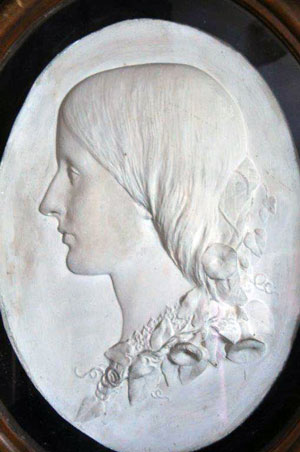
Josephine Elizabeth Grey
Campaigner and Reformer.
Born 13 April 1828 at Milfield Hill
Married Rev. George Butler on 8 January 1852 at St Andrews, Corbridge.
Died 30 December 1906 in Wooler. Buried at Kirknewton.

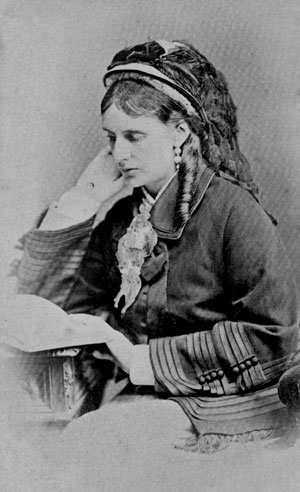


OBITUARY. MRS JOSEPHINE BUTLER
We regret to announce the death of Mrs. Josephine Butler, which occurred on Sunday night at Wooler, in Northumberland. A correspondent writes :-Josephine Grey was a Northumbrian, the daughter of John Grey, of Dilston, where she was born on April 13, 1829. In 1851 she met George Butler, then a tutor at Durham University, whom his intimate Froade described as ' the most variously gifted man in body and mind that I ever knew '; and the marriage took place at Dilston early in 1852. The first five years of her married life were spent at Oxford, where she proved a most capable and sympathetic helpmate to her husband, drawing maps for his lectures, or puzzling out old Chaucers in the Bodleian. It was here in Oxford that her indignation was first aroused against ' certain accepted theories in society' as 'that a moral lapse in a woman was immensely worse than in a man,' and that the social evil was to be passed over in silence. ' There echoed in my heart,' she says, ' the terrible prophetic words of the painter poet Blake;- "'The harlot's curse, from street to street, Shall weave old England's winding-sheet.' "It was here too that the Butlers, who were absolutely at one on the moral question, took from Newgate into their service a young betrayed mother who had been sentenced for the murder of her infant; 'the first of the world of unhappy women' who were thus welcomed. In 1857 came a double trial; her father's heavy losses by a bank failure, and her own ill-health, which made removal from Oxford imperative. Her husband now accepted the vice-principalship of Cheltenham College. At Cheltenham her health greatly improved, but a still greater trial was in store - the death of her only daughter by falling over a banister. From 1866 till 1882 her husband was principal of Liverpool College; and in that great city she was, as she says, ' possessed with an irresistible desire to go forth and find some pain keener than my own.' The result of her visits to the hospital and oakam-picking sheds of the Liverpool workouse, and to the quays, drew down upon her ' an avalanche of miserable but grateful womanhood.' Into the garrets of their house the Butlers ' crowded as many as possible of the most friendless girls who were anxious to make a fresh start.' In time the pair of good Samaritans established a House of Rest for such cases-which' long afterwards became a municipal institution-and also an industrial home for healthy and active but friendless girls. It was in 1860 that a group of medical men,who had been strenuously opposing the introduction of ‘the principle of regulation by the State of the social evil,' became convinced that some far' stronger force than scientific argument was needed to ensure success; and that women, 'insulted by the Napoleonic system,' must find champions among their own sex. Appeals for Mrs. Butler's help poured in, and the call seemed clear to her mind; but at first she shrank back. A woman of extreme delicacy and refinement of mind, with a horror not only of contact with vice, but of publicity and agitation, she was only driven to action by passionate love of purity and justice, and boundless love of her unhappy sister-women. She entered the arena in the spirit of a martyr going to the lions. ' The toils and conflicts of the years that followed,' she says, ' were light in comparison with the anguish of that first plunge.' Her husband, forseeing 'what it meant 'for her and for himself, loving peace and hating strife, his happiness (like hers) centering in domestic life, nevertheless recognized ' the call of God to conflict.' Mr. Butler- Canon Butler, as he became of Winchester-took an active and by no means perfunctory part in the movement; and on one occasion, at the Church Congress of 1872 in Nottingham, when he began to read a paper on 'The Duty of the Church of England in Moral Questions,' he was shouted down; but he was necessarily fettered by his work at Liverpool, and one of the many trials with which they paid for their devotion to public duty was the frequent separation of husband and wife. Together or apart, as Mrs. Butler says, they had to endure ' the cold looks of friends, the scorn of persons in office and high life, the silence of some from whom one hoped for encouragement, the calumnies of the Press, and occasionally the violence of hired mobs.' But, she adds, ' the working classes were always with us ' ; and the forces of organized religion by degrees ranged themselves largely, and in many cases enthusiastically, on the same side. One of her earliest helpers in the movement was Mrs. Butler's cousin, the Rev. Charles Birrell, a gifted Baptist minister at Liverpool- Mr. Augustine Birrell's father. Among the distinguished women who supported the movement were Florenco Nightingale, Hariet Martineau, and Mary Carpenter. The agitation spread to the Continent; international congresses were held, and a central office for the propaganda was established in Switzerland. In France Mgr. Dupanloup and M. Yves Guyot were among those who welcomed the Butlers' aid. In England a Royal Commission was appointed in 1871, but reported against the object of the agitation, though Mr. Cowper-Temple and Mr. Applegarth dissented from the view of their fellow Commissioners. The first debate and division on the subject in the House of Commons took place in 1873, when the attack on the Contagious Diseases Acts was repelled by 265 to 128 votes. Ten years more of persistent agitation led to a practical victory; the enforcement of the obnoxious laws was suspended in consequence of a vote of the House of Commons. In 1886 the House resolved, neminc contra- dicente, that the Acts ought to be repealed -an amendment, declaring that repeal should be accompanied with the provision of hospital accommodation for women voluntarily seeking admission, having been defeated by 245 to 131. The repeal actually came in April of the same year. " Canon Butler died in 1890, and it is from Mrs. Butlers published 'Recollections' of him that I have drawn the quotations in this article. Mrs. Butler also wrote a life of Catharine of Siena; a biography of Oberlin; and a sketch of her sister, Mine. Meuricoffre; besides such controversial books and pamphlets as 'Government by Police' and 'Personal Reminiscences of a Great Crusade.' She did not consider the crusade ended with the legislation of 1888; and in 1898, in a prefatory note to a pamphlet attacking the continuance in India of the system abolished in England, she wrote:-' I love my country. It is because of my great love for her . . that I will not cease to denounce the crimes committed in her name so long as I have life and breath.' Mrs. Butler's father had been an active worker with Clarkson for the abolition of the slave trade; and she herself, published in 1900 a book, 'Native Races and the War,' controverting the pro-Boer views of many of her friends. "Mrs. Butler is described by one of her fellow-workers as 'an almost ideal woman; a devoted wife, exquisitely human and feminine,with no touch in her of the " woman of the platform," though with a great gift of pleading speech; with a powerful mind, and a soul purged through fire.'"'
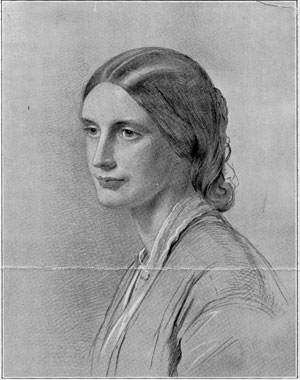
A great deal of information about Josephine is available online. The book she wrote about her father can also be read online here. Her "Personal Reminiscences of a Great Crusade" can be read online here. A book called "Josephine E Butler, An Autobiographical Memoir" can be read online here.
Papers related to Josephine Butler are held in the following repositories: Northumberland Record Office (ref: NRO.229) - correspondence and diaries (1851-1905); Liverpool University : Special Collections and Archives - correspondence and papers (c1853-1906) includes a further 155 letters, and other material from Josephine Butler Memorial House; Oxford University: Balliol College Library - papers related to Benjamin Jowett and correspondence; Royal Institute of British Architects Library (ref: BuFam/1/4, 2/4, 3/2, 4/2) - letters to Edith Rhoda and Arthur Stanley Butler etc (c1882-1906); further family correspondence is held at St Andrews University Library; letters (c.1860-65) to Hannah and Emily Ford etc. are in Leeds University, Brotherton Library.
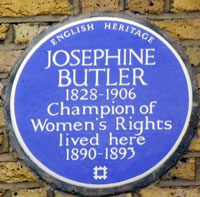

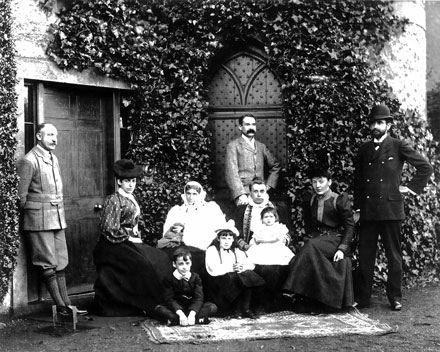
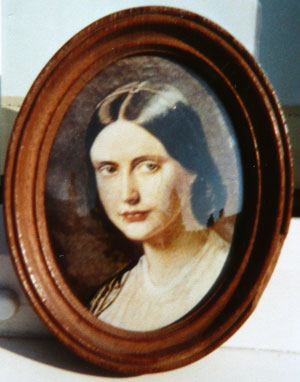
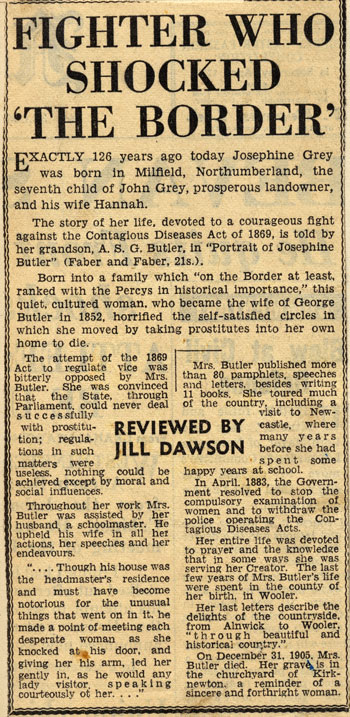

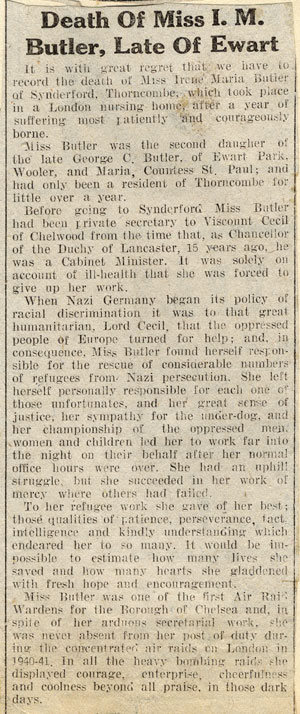

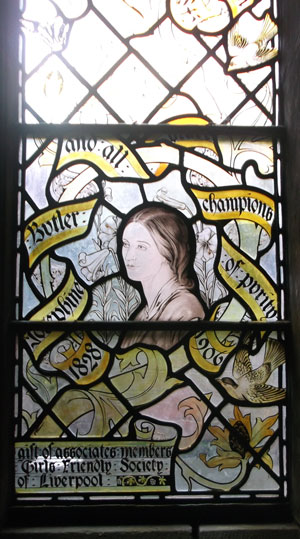
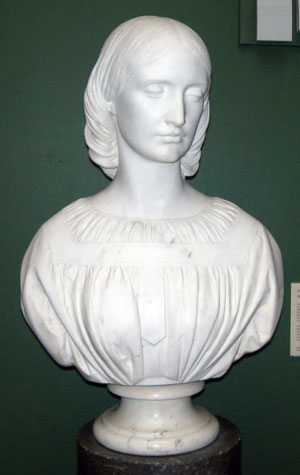
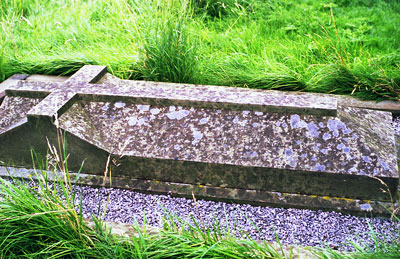
Death of Miss I. M. Butler, Late of Ewart.
It is with great regret that we have to record the death of Miss Irene Maria Butler of Synderford, Thorncombe, which took place in a London nursing home, after a year of suffering most patiently and courageously borne.
Miss Butler was the second daughter of the late George C. Butler of Ewart Park, Wooler, and Maria, Countess St. Paul; and had only been a resident of Thorncombe for little over a year.
Before going to Synderford Miss Butler had been Private secretary to Viscount Cecil of Chelwood from the time that, as Chancellor of the Duchy of Lancaster, 15 years ago, he was a Cabinet Minister. It was solely on account of her ill-health that she was forced to give up her work.
When Nazi Germany began its policy of racial discrimination it was to that great humanitarian, Lord Cecil, that the oppressed people of Europe turned for help; and, in consequence, Miss Butler found herself responsible for the rescue of considerable numbers of refugees from Nazi persecution. She left herself personally responsible for each one of those unfortunates, and her great sense of justice, her sympathy for the underdog, and her championship of the oppressed men, women and children led her to work far into the night on their behalf after a normal office hours were over. She had an uphill struggle, but she succeeded in her work of mercy where others had failed.
To her refugee work she gave of her best; those qualities of patience, perseverance, tact, intelligence and kindly understanding which endeared her to so many. It would be impossible to estimate how many lives she saved and how many hearts she gladdened with fresh hope and encouragement. Miss Butler was one of the first Air Raid Wardens for the Borough of Chelsea and, in spite of her arduous secretarial work, she was never absent from her post of duty during the concentrated air raids on London in 1940-41. In all the heavy bombing raids she displayed courage, enterprise, cheerfulness and coolness beyond all praise, in those dark days.
Refugees’ friend Miss Irene Butler, who died recently in a London nursing home, was the second daughter of the late George Grey Butler, of Ewart Park, near Wooler, Northumberland, and the grand-daughter of Josephine Butler, the social reformer.
Miss Butler was private secretary to Viscount Cecil of Chelwood for 15 years. When Germany began its policy of racial discrimination many of the oppressed people of Europe turned to Lord Cecil for help and Miss Butler assisted in saving numbers of refugees from being sent to concentration camps.
Her sense of justice and her indignant championship of the under-dog gave to her the sensation of being personally responsible for each one of these unfortunate people and she worked far into the night on their behalf.
"Many good-hearted English people made no headway against the restrictions imposed upon admissions to this country. Success was only possible by the exercise of patience, perseverance, tact and intelligence. To her refugee work Miss Butler gave, with Lord Cecil’s authority, those qualities in full measure and it would be impossible (writes a correspondent) to estimate the number of lives she saved and how many hearts she gladdened with encouragement and fresh hope.
Warden in "Post D"
Northumbrians who have read John Strachey’s "Post D" will be interested in the fact that Miss Butler figures therein as Miss Dalrymple, and a fellow woman warden, also in the book, in an appreciation, writes; "Irene Butler was among the first wardens to join up in Chelsea.
"She chose to be part of the garrison of London and that choice certainly helped to kill her. It was a choice that she made as the citizen of a free country, a civilised person sacrificing comfort for the sake of civilisation."
